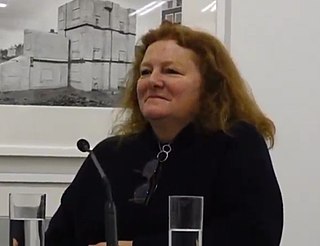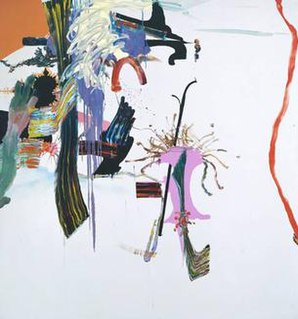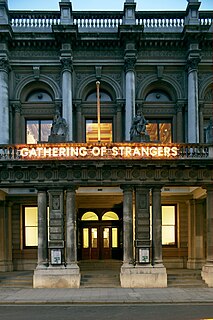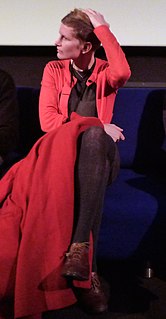Related Research Articles

The Turner Prize, named after the English painter J. M. W. Turner, is an annual prize presented to a British visual artist. Between 1991 and 2016, only artists under the age of 50 were eligible. The prize is awarded at Tate Britain every other year, with various venues outside of London being used in alternate years. Since its beginnings in 1984 it has become the UK's most publicised art award. The award represents all media.

Dame Rachel Whiteread is an English artist who primarily produces sculptures, which typically take the form of casts. She was the first woman to win the annual Turner Prize in 1993.

The Young British Artists, or YBAs—also referred to as Brit artists and Britart—is a loose group of visual artists who first began to exhibit together in London in 1988. Many of the YBA artists graduated from the BA Fine Art course at Goldsmiths, in the late 1980s, whereas some from the group had trained at Royal College of Art.

Mark Wallinger is a British artist. Having previously been nominated for the Turner Prize in 1995, he won in 2007 for his installation State Britain. His work Ecce Homo (1999–2000) was the first piece to occupy the empty fourth plinth in Trafalgar Square. He represented Britain at the Venice Biennale in 2001. Labyrinth (2013), a permanent commission for Art on the Underground, was created to celebrate 150 years of the London Underground. In 2018, the permanent work Writ in Water was realized for the National Trust to celebrate Magna Carta at Runnymede.

Bridget Louise Riley is an English painter known for her op art paintings. She lives and works in London, Cornwall and the Vaucluse in France.

Helen Chadwick was a British sculptor, photographer and installation artist. In 1987, she became one of the first women artists to be nominated for the Turner Prize. Chadwick was known for "challenging stereotypical perceptions of the body in elegant yet unconventional forms. Her work draws from a range of sources, from myths to science, grappling with a plethora of unconventional, visceral materials that included chocolate, lambs tongues and rotting vegetable matter. Her skilled use of traditional fabrication methods and sophisticated technologies transform these unusual materials into complex installations. Maureen Paley noted that "Helen was always talking about craftsmanship—a constant fount of information". Binary oppositions was a strong theme in Chadwick's work; seductive/repulsive, male/female, organic/man-made. Her combinations "emphasise yet simultaneously dissolve the contrasts between them". Her gender representations forge a sense of ambiguity and a disquieting sexuality blurring the boundaries of ourselves as singular and stable beings."
Catherine Yass is an English artist known for her wall-mounted lightboxes.
Anya Gallaccio is a British artist, who creates site-specific, minimalist installations and often works with organic matter.

Angela Bulloch, is an artist who often works with sound and installation; she is recognised as one of the Young British Artists. Bulloch lives and works in Berlin.
Jane Wilson and Louise WilsonRA Elect are British artists who work together as a sibling duo. Jane and Louise Wilson's art work is based in video, film and photography. They are YBA artists who were nominated for the Turner Prize in 1999.

Fiona Rae is a Hong Kong-born British artist. She is one of the Young British Artists (YBAs) who rose to prominence in the 1990s. Throughout her career, she has been known for having a portfolio of work that includes elements of energy, and complexity. Her work is known for aiming at expanding the modern traditions of painting.
Fiona Banner, also known as The Vanity Press is a British artist. Her work encompasses sculpture, drawing, installation and text, and demonstrates a long-standing fascination with the emblem of fighter aircraft and their role within culture and especially as presented on film. She is well known for her early works in the form of 'wordscapes', written transcriptions of the frame-by-frame action in Hollywood war films, including Top Gun and Apocalypse Now. Her work has been exhibited in prominent international venues such as the Museum of Modern Art, New York and Hayward Gallery, London. Banner was shortlisted for the Turner Prize in 2002.
Rebecca Jane Warren is a British visual artist and sculptor, born in Pinhoe, Exeter. She is particularly well known for her works in clay and bronze and for her arranged vitrines. The artist currently lives and works in London.

Shirazeh Houshiary is an Iranian-born English sculptor, installation artist, and painter. She lives and works in London.

Nathan Coley is a contemporary British artist who was shortlisted for the Turner Prize in 2007 and has held both solo and group exhibitions internationally, as well as his work being owned by both private and public collections worldwide. He studied Fine Art at Glasgow School of Art between 1985 and 1989 with the artists Christine Borland, Ross Sinclair and Douglas Gordon amongst others.
Cathy Wilkes is a Northern Irish artist who lives and works in Glasgow. She makes sculpture, paintings, and installations. She was the recipient of the Inaugural Maria Lassnig Prize in 2017 and was commissioned to create the British Pavilion in Venice in 2019.
Marisa Merz was an Italian artist and sculptor. In the 1960s, Merz was the only female protagonist associated with the radical Arte povera movement. In 2013 she was awarded the Golden Lion for Lifetime Achievement at the Venice Biennale. She lived and worked in Turin, Italy.

Laure Prouvost is a French artist living and working in Antwerp, Belgium. She won the 2013 Turner Prize. In 2019, she represented France at the Venice Biennale with the multi-media work "The Deep Blue Sea Surrounding You".

Rose Wylie is a British painter. She is an artist known for creating large paintings on unprimed canvas.
Tai Shani is a British artist. Shani uses performance, film, photography, sculptural installations and experimental texts to explore forgotten histories and stories. She is currently a Tutor in Contemporary Art Practice at the Royal College of Art. Shani was born in London.
References
- 1 2 Takahashi, Tomoko (2005). Tomoko Takahashi. Steiner, Rochelle., Serpentine Gallery. London: Serpentine Gallery. ISBN 1905190026. OCLC 85690686.
- ↑ "Tomoko Takahashi - 8 February - 10 March 2007". Hales Gallery. Retrieved 24 November 2018.
- ↑ Withers, Rachel. Tomoko Takahashi Archived 2008-12-03 at the Wayback Machine Frieze, 39, 1998.
- ↑ Preece, Robert. Tomoko Takahashi: Staging controlled chaos (interview). ArtAsiaPacific / artdesigncafe, 2000.
- ↑ Tomoko Takahashi. Exhibition announcement, Hammer.
- ↑ Jones, Jonathan. Tomoko Takahashi, Guardian, 28 February 2005.
- ↑ Tomoko Takahashi - Introspective Retrospective. Exhibition announcement, De La Warr Pavilion.
- ↑ Tomoko Takahashi. Artist listing, Tate Collection.
- ↑ Tate. "Turner Prize 2000 – Exhibition at Tate Britain | Tate". Tate. Retrieved 24 November 2018.
- ↑ "Tomoko Takahashi (B. 1966)". invaluable.com. Retrieved 6 March 2020.
- ↑ "Tomoko Takahashi (B. 1966)". invaluable.com. Retrieved 6 March 2020.
- ↑ "Tomoko Takahashi | artnet". www.artnet.com. Retrieved 6 March 2020.